Notolabrus gymnogenis
Notolabrus gymnogenis, commonly known as the crimson banded wrasse, is a species of fish in the family Labridae. This colourful fish is endemic to Eastern Australia.
| Notolabrus gymnogenis | |
|---|---|
.jpg.webp) | |
| male | |
 | |
| female | |
| Scientific classification | |
| Kingdom: | Animalia |
| Phylum: | Chordata |
| Class: | Actinopterygii |
| Order: | Labriformes |
| Family: | Labridae |
| Genus: | Notolabrus |
| Species: | N. gymnogenis |
| Binomial name | |
| Notolabrus gymnogenis (Günther, 1862) | |
| Synonyms[2] | |
Description
This species grows to ~40 cm, and is like many wrasses, its colour changes over different stages of its life.[3] Juveniles are greenish brown with rows of white spots along the sides. Females are reddish to brownish-orange with rows of white spots along the sides. Males are brightly coloured with red dorsal and anal fins, a red band around the rear of the body, a white caudal peduncle and a yellow caudal fin.[4] The largest male recorded had a standard length of 23 centimetres (9.1 in).[2]
Distribution
The fish is found in coastal waters of eastern Australia from Hervey Bay, Queensland to Lakes Entrance, Victoria and also in Tasmania. It has also been recorded from Lord Howe Island.[4]
Behaviour
Males are territorial and will defend a territory against other males.[4] They are protogynous being born female, and changing sex to a male later on in life, at a standard length of 13–20 centimetres (5.1–7.9 in).[5] The males gather a harem pf around 10 females and juveniles into their territory.[4] This is an oviparous fish which forms pairs to spawn.[2]
Habitat
Notolabrus gymnogenis are benthic coastal reef inhabitants and are commonly found on reef in New South Wales.[6] Found in depths of 4–53 metres (13–174 ft).[6][7]
Diet
Notolabrus gymnogenis feeds mostly on benthic invertebrates, the juveniles mostly prey on amphipods, while the larger individuals prey on decapods, gastropods and bivalves.[4]
Human usage
Notolabrus gymnogenis is a quarry for recreational fishing and has also been recorded being sold commercially in the Sydney Fish market 2005.[1]
References
- Russell, B. (2010). "Notolabrus gymnogenis". IUCN Red List of Threatened Species. 2010: e.T187633A8586162. doi:10.2305/IUCN.UK.2010-4.RLTS.T187633A8586162.en. Retrieved 19 January 2020.
- Froese, Rainer and Pauly, Daniel, eds. (2006). "Notolabrus gymnogenis" in FishBase. AugustIyear=2019 2006 version.
- "Crimsonband Wrasse, Notolabrus gymnogenis (Günther, 1862) - Australian Museum". australianmuseum.net.au.
- Bray, Dianne. "Notolabrus gymnogenis". Fishes of Australia. Museums Victoria. Retrieved 2 October 2018.
- Russell, B. C. (1988). "Revision of the labrid fish genus Pseudolabrus and allied genera" (PDF). Records of the Australian Museum. Supplement 9: 1–72.
- Fetterplace, Lachlan C.; Turnbull, John W.; Knott, Nathan A.; Hardy, Natasha A. (28 August 2018). "The Devil in the Deep: Expanding the Known Habitat of a Rare and Protected Fish". European Journal of Ecology. 4 (1): 22–29. doi:10.2478/eje-2018-0003.
- Fetterplace, L; Knott, N. "Offshore Reef Fishes of South Coast NSW". figshare. doi:10.6084/m9.figshare.5947012.v1.
